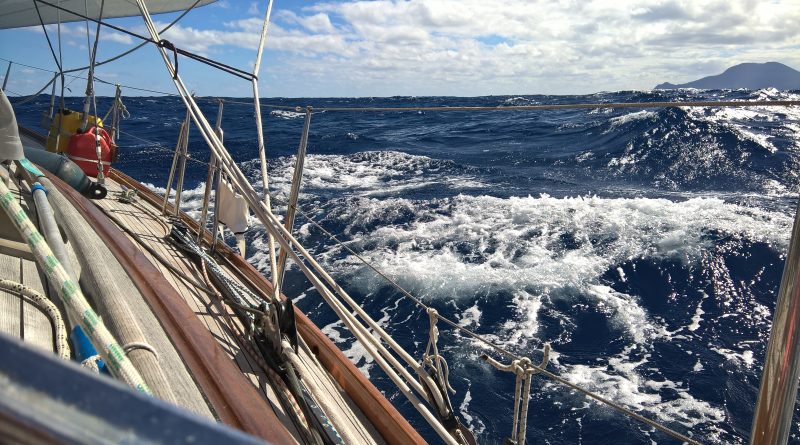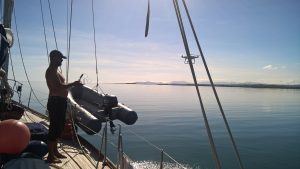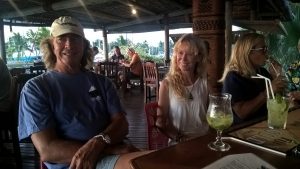180 degrees: Welcome to The Cannibal Isles
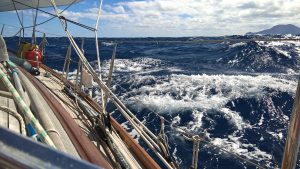
Our 550 mile passage to Fiji from Tonga was mostly fast and often exciting/exhausting. We had at least Force 6 winds on the beam or quarter the whole way, sometimes 7 or 8. Even the swell was with us for the last 150 miles or so. We regularly clocked over 8 knots and as we neared the islands we dropped the mizzen and reefed the genoa hard so that we wouldn’t arrive too early. Despite our best efforts to stand on the brakes, there was nonetheless too much wind and so we still arrived in the dark. Thank goodness there are leading lights through Malolo Passage and so, with quite a lot of excitement but no drama, we motored through the opening in the barrier reef and dropped anchor in Momi Bay for a few hours R&R.
“They are a people who delight in war. They have an almost
unappeasable appetite for it. Connected with their frequent wars is
an evil for which I should think Fiji to be preeminent, and that is
Cannibalism, an evil which may have originated in revenge, but
which has now grown into a confirmed appetite and fondness for
human flesh…
(…)
Fiji I think exceeds New Zealand in that abominable vice. The accounts we hear
are sickening: it is not one now and then who furnishes a meal for his
canine countrymen, nor ten nor twenty, but hundreds.
When I first heard it I was incredulous, and confident that the statement was
exaggerated, but upon appealing to the authority of a Fijian Chief at
present here, I was assured by him that it was ‘mooni aubito’
[mo’oni ’aupito] (most true) that some short time ago there were more than
Two hundred human bodies prepared for a single feast!”

Thus wrote James Watkin in a letter home to the London Missionary Society in 1834. The reputation of Fiji as the Cannibal Isles spread far and wide thanks to the – probably slightly florid and overenthusiastic – letter writing of such isolated and embattled missionaries. If you were dumped on a remote island and given the task of converting people whose language you don’t speak and who seem perfectly happy with their own belief system, with only your recently acquired wife for company, you’d probably exaggerate a bit in your letters home too. However, before I pooh-pooh the idea entirely, it’s worth noting that the Guinness Book of Records lauds the Fijian chief Ratu Udre Udre as the most prolific cannibal of all time. He died in about 1840, but not before he had eaten between 872 and 999 humans in his lifetime. That’s pretty good going. Apparently he used to stand on the hillside and thump the ground with a massive stick to proclaim his hunger for human flesh. The ‘future meals’ that were being kept prisoner in the tangle of the mangroves can’t have particularly enjoyed hearing that sound. He appears to have been (thankfully!) somewhat of an anomaly though. It seems that it was more common to eat your enemy slain in battle in an attempt to assume his knowledge, cunning and power, but some accounts suggest that cannibalism began as a purely pragmatic way of avoiding dying of starvation, particularly on long sea voyages. Judging from the ‘cannibal head forks’ and cannibal dolls you can buy in souvenir shops, it’s not however a tradition that the Fijians seem in any rush to disown!
Fiji comprises a whopping 332 islands and isletsm centred along the 180th meridian at 18 degrees south. In layman’s terms, we are on the other side of the world from Greenwich, London. We’d have to go a few more degrees south – somewhere much colder, south of NZ in fact – to be exactly on the other side of the world from London, but it certainly feels like we are, whether or not there are still any cannibals out here. (Just for interest, Fiji is exactly on the other side of the world from the Timbuktu area in Mali in NW Africa.)
The two main islands – Viti Levu and Vanua Levu, along with the picturesque Yasawa Group and Lomaitivi Group – are situated on the western platform of a submerged mountain chain on the continental shelf. We made landfall on the western coast of Vanua Levu, the larger and more westerly of the two islands. The eastern platform supports the Lau Group, through which we successfully sailed on the way here without hitting anything (this is always a relief). The Lau Group island chain is about 80 islands, spread out in a line about 400 miles long. Between them are numerous reefs and shoals, which we spent much time avoiding on this passage.
(As an aside, the Fijians have also contested ownership of Minerva Reef some way south but on the Lau Group platform. Tonga appear to have claimed the Minerva Reef and now regularly sends patrol boats to check that no one is attempting a repeat of January 1972, when the American billionaire and all-round dodgy geezer Michael J. Oliver began to have sand delivered from Australia to build an utopian republic on the more southerly reef. It’s a fascinating story and well worth googling.)
Anyway, after a couple of hours of well-earned sleep in Momi Bay, with not a cannibal (but two hornets which I summarily dispatched) in sight, we motor-sailed up the western coast of Vanua Levu, on our way to Lautoka. Lautoka is an official Port of Entry and the second city after Suva. We radioed ahead repeatedly and when we finally arrived and anchored off the wharf just after 4pm on Saturday, I was really disappointed to hear that actually the Customs Official had decided to go home and would not check us in until Sunday morning. AARRRGGGH. Dietmar was incredibly sanguine about the whole thing and I, unusually for me, was really disappointed and cross. For about five minutes. Then I remembered that we had finally caught the ARC fleet up, having given them a 2 month headstart. Wooohoooo!! Anyone who is friends with either of us on Facebook will find a video showing just how happy I was with this thought. There is a risk that you will die laughing. And thank goodness I don’t have any children or they would probably have disowned me by now.
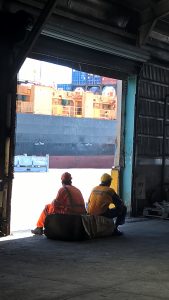
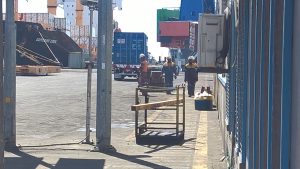 The form filling in Fiji is nowhere near as onerous as in Tonga, but checking in still took over 6 hours. First we had to see the man from Health, then we could talk to Customs, Immigration and last Biosecurity. Between all these meetings, we hung around in the busy dock where two container ships were being loaded and unloaded. A constant stream of forklifts, low-loaders and trucks with trailers chuntered back and forth in front of the offices. Massive shipping containers were loaded and unloaded deftly from the ships by massive cranes. Stevedores, languid in the Sunday afternoon heat, sat around in the shade waiting for their next assignment. A security guard fished from the bridge. Bored waiting, I broke the rules about staying put in the freezing cold air-conditioned offices and dared to walk the 50 yards to chat to him. Hand-lining, crouched on the edge of the bridge in his hard hat, steel toe-capped boots and high viz waistcoat with SECURITY emblazoned across the back, he seemed pleased to have company for a while. After the usual ‘where are you from, how did you get here, wow that’s a long way’ conversation, we talked about fishing and he told me that these fish were called ‘bread fish.’
The form filling in Fiji is nowhere near as onerous as in Tonga, but checking in still took over 6 hours. First we had to see the man from Health, then we could talk to Customs, Immigration and last Biosecurity. Between all these meetings, we hung around in the busy dock where two container ships were being loaded and unloaded. A constant stream of forklifts, low-loaders and trucks with trailers chuntered back and forth in front of the offices. Massive shipping containers were loaded and unloaded deftly from the ships by massive cranes. Stevedores, languid in the Sunday afternoon heat, sat around in the shade waiting for their next assignment. A security guard fished from the bridge. Bored waiting, I broke the rules about staying put in the freezing cold air-conditioned offices and dared to walk the 50 yards to chat to him. Hand-lining, crouched on the edge of the bridge in his hard hat, steel toe-capped boots and high viz waistcoat with SECURITY emblazoned across the back, he seemed pleased to have company for a while. After the usual ‘where are you from, how did you get here, wow that’s a long way’ conversation, we talked about fishing and he told me that these fish were called ‘bread fish.’
“Because they taste like bread?” I asked.
“No, because they like eating bread.”
He was using a piece of fish as bait. “Have you caught any?”
“Not yet”
“Why are you using fish as bait?”
“Because I don’t have any bread…”
“Oh…”
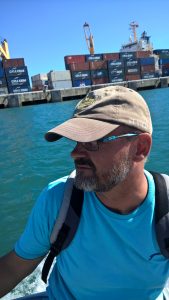 The man from Biosecurity, a faintly effete and timid young man with very long eyelashes, apparently quite new to the job, went out to CESARINA in the dinghy with Dietmar to make an inspection and verify that we weren’t importing plagues or pestilences. He boarded CESARINA without taking his heavy black boots off and left marks on the deck. Dietmar, predictably cross about this, repaid the favour by making sure that his dinghy passage back to the port was both wet and fast.
The man from Biosecurity, a faintly effete and timid young man with very long eyelashes, apparently quite new to the job, went out to CESARINA in the dinghy with Dietmar to make an inspection and verify that we weren’t importing plagues or pestilences. He boarded CESARINA without taking his heavy black boots off and left marks on the deck. Dietmar, predictably cross about this, repaid the favour by making sure that his dinghy passage back to the port was both wet and fast.
During this lengthy process, we also met Richard, the captain of ALANI II, a privately-owned gin palace that he had just motored up from New Zealand, ready for her Australian owner to arrive. Kicking my heels in the office, I volunteered to help him fill out the reams of paperwork for his several crew. He had caught several yellowfin tuna over a seamount on the way here and offered to share his catch with us, which we keenly accepted. You scratch my back…
The end was in sight – only Customs and a fairly large bill because a) they can, b) it was Sunday and c) I had in fact been honest about how much alcohol we have on board. It’s not much, but you have to pay duty on it. Lovely Customs lady needed her fees paying exactly in Fijian dollars (which of course we didn’t have because we weren’t allowed ashore yet…) and said she would wait while we walked to the ATM. I asked for directions. She started to explain and then, with a sigh, said she would take us. Result. We climbed into her battered Nissan Sunny and drove a good 5 minutes on fairly empty roads into Lautoka town. We chatted away and found out that she had lived in Japan for 5 years, that her husband is a professional rugby player. Thank goodness for her kindness – we would have been walking for hours.
Finally, we were finished. Exhausted, thirsty, starving, we dinghied to CESARINA and I knocked up a late lunch. It was about 3pm and we were looking forward to catching up – finally! – with some ARC buddies. Yay! The plan was to anchor in Saweni Bay and then walk round to Vuda Point marina, about 1.5 miles. We were just getting ready to weigh anchor when we were called on the VHF. “Was that call for us?” I asked Dietmar. “Keine Ahnung (no idea)” he said. It came through again – it was the young man with the eyelashes from Biosecurity who had forgotten both to give us the clearance forms and also to charge us for the inspection and for taking the rubbish away. What?! Oh for goodness’ sake…
An hour and a half and over 300 Fijian dollars (about 150 Euros) later, we eventually could leave. We motored down to Saweni Bay just in time for the sun to disappear behind the horizon. I opened a bottle of wine and we feasted on yellowfin tuna sashimi. Thank you, ALANI II.
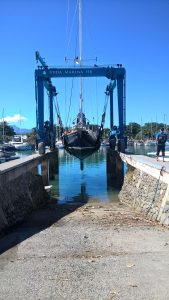 48 hours later and we are on the hard in Vuda Point marina. Dietmar was really anxious on the way in as we only had 10cm of water under the hull. By contrast, our haulout was extremely nerve-wracking for me and Dietmar was super calm and cool. Watching CESARINA being lifted out of the water was slightly surreal. With 9’of draft she just keeps coming…
48 hours later and we are on the hard in Vuda Point marina. Dietmar was really anxious on the way in as we only had 10cm of water under the hull. By contrast, our haulout was extremely nerve-wracking for me and Dietmar was super calm and cool. Watching CESARINA being lifted out of the water was slightly surreal. With 9’of draft she just keeps coming…
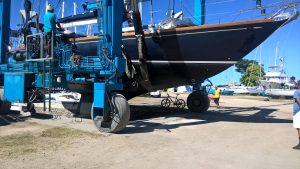 A rig check showed two shrouds that were about to give up the ghost (thank God I didn’t know about that before) so now we are awaiting new shrouds and a new forestay. There are men everywhere doing things… engine service, generator service, new antifouling, hull polishing. It is really hot out of the water – over 40 degrees in the blazing sunshine – but it’s not for long.
A rig check showed two shrouds that were about to give up the ghost (thank God I didn’t know about that before) so now we are awaiting new shrouds and a new forestay. There are men everywhere doing things… engine service, generator service, new antifouling, hull polishing. It is really hot out of the water – over 40 degrees in the blazing sunshine – but it’s not for long.
It feels amazing that we have finally caught up the fleet. It’s a bit galling that we don’t think we are going to make it to Musket Cove much before we have to leave, but at least this time we will be leave with the fleet. It’s really reassuring to know that there are people around again who might be able to assist if you have a problem. Dietmar and I have however learned a lot about each other and about CESARINA in the last few months where we have been sailing without a safety net…
We are very happy to be once again in the company of Atla and Aurora and Sandvita and now Taistelai (although several people are quite badly ill and are either dropping out of the rally entirely or delaying their departure to catch up in Australia. We wish Helen in particular the very best for a speedy recovery.) We are also making new friends (Hello, AMOSEA ISLAND :D) and I am often to be found sitting at the bar on the waterfront, supping delicious smoothies and rejoicing in not having to cook.
One last thing: The last officially recorded act of cannibalism was the murder and consumption of the Rev. William Baker in 1867 along with his 7 Fijian Christian helpers, but there is open speculation in some circles as to whether cannibalism is still alive and well in more remote areas today. Apparently, ‘long pig’ tastes like pork but sweeter. The locals here all seem to be super friendly and despite the delicious food in the restaurant, I have lost far too much weight to be of any interest to those who may be a little hungrier.
Dietmar, on the other hand… 😉

